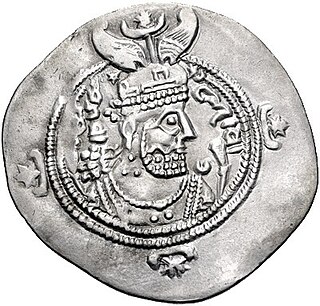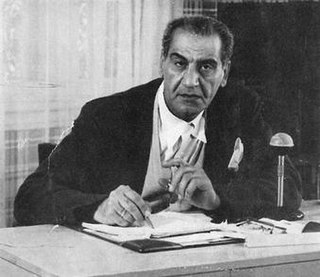
Khosrow II, commonly known as Khosrow Parviz, is considered to be the last great Sasanian King of Kings (Shahanshah) of Iran, ruling from 590 to 628, with an interruption of one year.

Yazdegerd III was the last Sasanian King of Kings from 632 to 651. His father was Shahriyar and his grandfather was Khosrow II.

Bahram V, also known as Bahram Gur, was the Sasanian King of Kings (shahanshah) from 420 to 438.

Oshin was king of the Armenian Kingdom of Cilicia, ruling from 1307 to 1320. He was a member of the House of Lampron, the son of Leo II, King of Armenia and Queen Keran.
Bohemond VI, also known as the Fair, was the prince of Antioch and count of Tripoli from 1251 until his death. He ruled while Antioch was caught between the warring Mongol Empire and Mamluk Sultanate. He allied with the Mongols against the Muslim Mamluks and his Crusaders fought alongside the Mongols in their battles against the Mamluks. The Mamluks would achieve a historic victory against the Mongols and halt their advance westwards at the Battle of Ain Jalut. In 1268 Antioch was captured by the Mamluks under Baybars, and he was thenceforth a prince in exile. He was succeeded by his son, Bohemond VII.

Isaac or Sahak of Armenia was the catholicos of the Armenian Church from c. 387 until c. 438. He is sometimes known as Isaac the Great or Sahak the Parthian in reference to his father's Parthian origin. He was the last Armenian patriarch who was directly descended from Gregory the Illuminator, who converted the Kingdom of Armenia to Christianity in the early fourth century and became the first head of the Armenian Church. He supported Mesrop Mashtots in the creation of the Armenian alphabet and personally participated in the translation of the Bible into Armenian.

Al-Malik Al-Ashraf Salāh ad-Dīn Khalil ibn Qalawūn was the eighth Turkic Bahri Mamluk sultan, succeeding his father Qalawun. He served from 12 November 1290 until his assassination in December 1293. He was well known for conquering the last of the Crusader states in Palestine after the siege of Acre in 1291. While walking with a friend, Khalil was attacked and assassinated by Baydara and his followers, who was then killed under the orders of Kitbugha.

Ashot II the Iron was king of Bagratid Armenia from 914 to 929. He was the son and successor of King Smbat I. His reign was filled with rebellions by vassals and pretenders to the throne, as well as foreign invasions, which Ashot fought off successfully, for which he is remembered by the epithet Yerkat’ (Երկաթ), or the Iron.

Sasanian Armenia, also known as Persian Armenia and Persarmenia, may either refer to the periods in which Armenia was under the suzerainty of the Sasanian Empire or specifically to the parts of Armenia under its control such as after the partition of 387 when parts of western Armenia were incorporated into the Eastern Roman Empire while the rest of Armenia came under Sasanian suzerainty but maintained its existing kingdom until 428.
The Roman–Parthian War of 58–63 or the War of the Armenian Succession was fought between the Roman Empire and the Parthian Empire over control of Armenia, a vital buffer state between the two realms. Armenia had been a Roman client state since the days of Emperor Augustus, but in 52/53, the Parthians succeeded in installing their own candidate, Tiridates, on the Armenian throne.

Vramshapuh was a noble of the Arsacid dynasty who served as the Sasanian client king of Armenia from 389 until his death in 414. He is mainly remembered for presiding over the creation of the Armenian alphabet by Mesrop Mashtots.

Movses Khorenatsi was a prominent Armenian historian from late antiquity and the author of the History of the Armenians.

The Kingdom of Vaspurakan was a medieval Armenian kingdom centered on Lake Van, located in what is now eastern Turkey and northwestern Iran. It was named after Vaspurakan, a province of historic Greater Armenia. Ruled by the Artsruni dynasty, it competed and cooperated with the Bagratuni-ruled Kingdom of Armenia for a little over a century until its last king ceded the kingdom to the Byzantine Empire in 1021.

The Georgian–Seljuk wars, also known as Georgian Crusade, is a long series of battles and military clashes that took place from 1064 until 1213, between the Kingdom of Georgia and the different Seljukid states that occupied most of South Caucasus. The conflict is preceded by deadly raids in the Caucasus by the Turks in the 11th century, known in Georgian historiography as the Great Turkish Invasion.

Vahan Mamikonian was an Armenian nobleman from the Mamikonian family. In 481 he rebelled against the Sasanian Empire that controlled the eastern part of Armenia known as Persian Armenia. He was appointed as marzban (governor) of Persian Armenia in 485 and remained in that post until his death around 503-510.
Shapur Mihran, known in Armenian sources as Shapuh Mihran, was a Sasanian nobleman from the House of Mihran. He served as the marzban of Persian Armenia briefly in 482.

Gourgen Mkrtich Yanikian was an Armenian genocide survivor. He is best known for the assassination of two Turkish consular officials, Consul General Mehmet Baydar and Consul Bahadır Demir. The event took place in Santa Barbara, California in 1973.
The Bagratuni family tree describes the heritage of the Bagratuni family in Armenia. Bagratuni lineage also lays claim to the Georgian Bagrationi dynasty.
Sahak Sevada was ruler of Gardman between 895–940 and father-in-law of King Ashot II of Armenia. He was the son of Grigol Hamam and brother of Atrnerseh, ruler of Hereti. His possessions covered Parisos, a district of Artsakh, as well as part of Utik-Gardman and Dzoroget.

The fall of Outremer describes the history of the Kingdom of Jerusalem from the end of the last European Crusade to the Holy Land in 1272 until the final loss in 1302. The kingdom was the center of Outremer—the four Crusader states—formed after the First Crusade in 1099 and reached its peak in 1187. The loss of Jerusalem in that year began the century-long decline. The years 1272–1302 are fraught with many conflicts throughout the Levant as well as the Mediterranean and Western European regions, and many Crusades were proposed to free the Holy Land from Mamluk control. The major players fighting the Muslims included the kings of England and France, the kingdoms of Cyprus and Sicily, the three Military Orders and Mongol Ilkhanate. Traditionally, the end of Western European presence in the Holy Land is identified as their defeat at the Siege of Acre in 1291, but the Christian forces managed to hold on to the small island fortress of Ruad until 1302.














